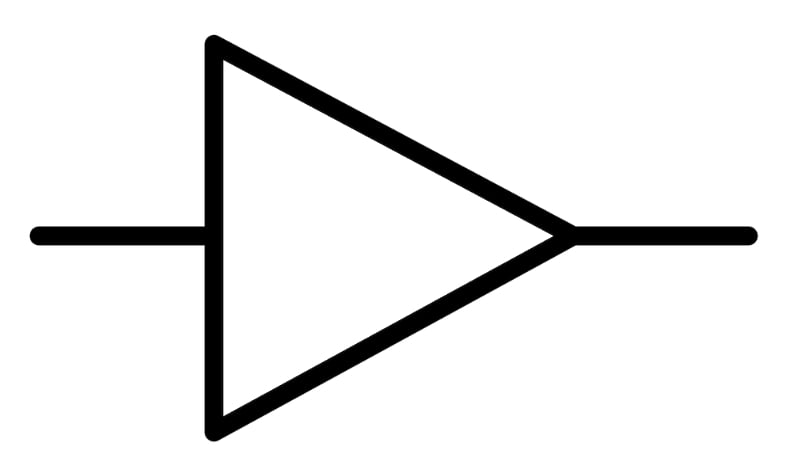LNAs, PAs, mixers. . . . Learn about active components used in RF systems.
As with passive components, the active components used in RF circuits share many characteristics with active components typically found in lower-frequency analog systems. However, there are certain components that are highly specific to RF design. Furthermore, different semiconductor technologies are often employed to ensure that RF components maintain adequate performance at very high frequencies.
Amplifier circuits, often built around an operational amplifier, are extremely common in both low-frequency and high-frequency analog design. In RF systems, there are two fundamental types of amplifiers: power amplifiers and low-noise amplifiers. The former are used to increase the power level of an RF signal prior to transmission, and the latter are used to amplify the (often very small) signals received by the antenna.

The power amplifier, or PA, is used to increase the power level of the signal before it is sent to the antenna. A similar situation is found in audio circuits: the audio signal’s amplitude may be perfectly adequate in terms of voltage, but a power amplifier is needed to supply large amounts of current to the speaker coil. In audio, more current corresponds to more power, and this in turn corresponds to more volume. In RF, higher power means longer range.
There are many non-RF applications that require low-noise amplification, but the specific phrase “low-noise amplifier” is common only in the context of RF. Actually, we usually hear the abbreviated version of the term, i.e., LNA.
The received signal delivered by an antenna can be of very low magnitude, and furthermore, it is buried in noise. This signal needs to be amplified for further processing, but it is also important to minimize further degradation of the signal-to-noise ratio. Thus, a low-noise amplifier is designed to provide high voltage gain while contributing minimal noise.
The noise performance of an LNA is quantified via the “noise figure” (NF), which corresponds to the amount of SNR degradation (in dB) created by the amplifier. Thus, an ideal amplifier would have NF = 0 dB, and as noise performance declines, NF increases.
Another fundamental RF component is the mixer. This name can be misleading; an RF mixer does not combine signals as an audio mixer does. Rather, an RF mixer takes two input frequencies and generates a third output frequency via multiplication. In other words, a mixer performs frequency translation.

Mixers allow signals to be shifted to higher or lower frequencies in a way that maintains the details of the signal. For example, an information-carrying (i.e., modulated) baseband signal can be shifted to a higher frequency that is suitable for wireless transmission, and the transmitted signal will retain the important modulation details that were present in the baseband signal.
The actual generation of a periodic signal is more closely related to the domain of passive components, but active components are used to manipulate these periodic signals. A phase-locked loop (PLL) is actually a system of subcomponents—at minimum, a phase detector, a low-pass filter, a voltage-controlled oscillator (VCO), and a frequency divider—that allows a wide variety of output frequencies to be generated from one input frequency.

Combining a PLL with a high-precision temperature-compensated oscillator converts a highly accurate but fixed reference frequency into a system that can produce highly accurate yet variable output frequencies. An oscillator combined with a PLL is referred to as a synthesizer, i.e., a component that can generate a range of frequencies.
This ability to adjust the oscillator frequency is very important in RF design. A particular system may need to operate on different channels in order to avoid interference, and thus the oscillation circuitry must be adjustable with respect to frequency. Furthermore, the frequency spacing between adjacent channels may be relatively small, and thus the adjustments must be precise.
Though not standard components in the context of historical RF engineering, it is important to recognize that analog-to-digital converters (ADCs) and digital-to-analog converters (DACs) are increasingly important in many RF systems. ADCs and DACs allow RF systems to benefit from the special capabilities offered by digital-signal-processing techniques and from the general flexibility and convenience associated with software-based solutions.
The term “software-defined radio” (SDR) refers to wireless communication systems that rely on software to implement important portions of the RF signal chain. Data converters are critical components in such systems—for example, a DAC could be used to directly generate a baseband waveform, or an ADC could be used to digitize a received baseband waveform (followed by further analysis in a digital signal processor).
SDRs can introduce additional design complexity, but they also offer advantages that are particularly valuable in certain applications.
Silicon is still the dominant material in semiconductor manufacturing. However, other materials are more compatible with the high signal frequencies present in RF systems. Three alternative materials that are used in RF semiconductors are gallium nitride (GaN), gallium arsenide (GaAs), and silicon germanium (SiGe). Specialized semiconductor technologies make it possible to fabricate devices that maintain adequate performance at extremely high frequencies, i.e., above 100 GHz.
As with low-frequency devices, the fundamental active component in RF integrated circuits is the transistor. However, thus far we have used the word “component” to refer to devices that may consist of numerous transistors. It is important to understand the justification for this: Designing high-performance, high-frequency RF components is extremely challenging and not within the skill set of many RF engineers. Practical RF engineering is focused on combining these components into functional circuits and then dealing with the various complicated issues that arise.

In Partnership with MacroFab

by Duane Benson

by Jeff Child


by Duane Benson